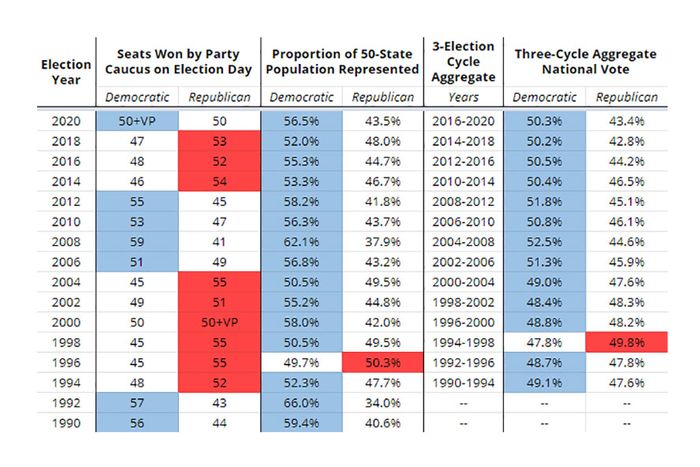It's pretty commonly known that Democrats have owned the popular vote in presidential elections for decades. If the president had been elected by popular vote rather than through the byzantine electoral college system, there would have been exactly one Republican administration since 1988. That's right: Democrats won the popular vote in every presidential election since then -- 32 years -- except for 2004, when W. defeated John Kerry, taking 50.7% of the popular vote (and 286 votes to 251 in the electoral college, the 7th smallest margin in U.S. electoral history -- and one of the tighter elections was in 2000, when Al Gore won the popular vote but W. squeaked through in the electoral college, 271 to 266).
It's not so commonly known that Democrats have also dominated the Senate -- Republican
senators haven’t represented a majority of the U.S. population since
1996 and haven’t together won a majority of Senate votes since 1998. In 2016, the Republicans hit the trifecta, winning the presidency and both the House and the Senate -- and the 52 Republican senators represented 44.7% of the population, while the 48 Democratic senators represented 55.3%.
Click here for an article in New York magazine by Ed Kilgore, entitled "Republican Senators Haven't Represented a Majority of Voters Since 1996."
Daily Kos Elections has come up with a chart displaying the percentage of the population represented by senators from each party since 1990, along with the percentage of Senate votes each party captured (displayed in three-cycle averages, since only one-third of the Senate is up for reelection every two years):

Republican senators haven’t represented a majority of the U.S. population since 1996 and haven’t together won a majority of Senate votes since 1998. Yet the GOP controlled the Senate from 1995 through 2007 (with a brief interregnum in 2001–02 after a party switch by Jim Jeffords) and again from 2015 until 2021.
As Stephen Wolf observed in his write-up of the results, there have been consequences for this disconnect:
Five Supreme Court justices (and many more lower court judges) were confirmed by senates where the GOP majority was elected with less popular support than Democrats. Those right-wing hardliners are now poised to use their control over the court to attack voting rights and preserve Republican gerrymanders while striking down progressive policies. This same minority rule has also paved the way for massive tax cuts for the rich under George W. Bush and Donald Trump that have facilitated an explosion in economic inequality.
Thanks to the filibuster, of course, on many key measures, the 43.5 percent of voters represented by a Republican minority in the Senate have as much clout as the 44.7 percent represented by a Republican majority when the GOP won a trifecta four years ago. That’s why Democrats are trying to cram as much legislation as they can into a budget-reconciliation bill that cannot be filibustered and why the parliamentarian’s ruling on the scope of that bill is such a big deal for Americans trying to survive on minimum wage.
Understanding the realities of our constitutional system means recognizing its injustices, too — along with injustices like the filibuster, which cannot be attributed to the Founders.

0 comments:
Post a Comment